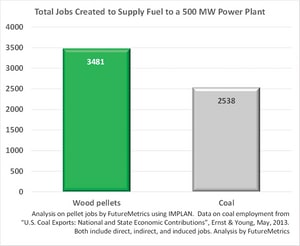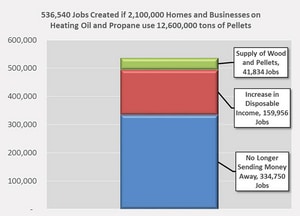The Path Ahead
Looking at the positive projections for the pellet industry, the
domestic pellet industry is understandably cautious. After all, the last
boom cycle in pellet expansion was followed by price-depressing excess
capacity. But with the industrial export market booming, and the
potential for the export fever to spread to premium heating pellets,
domestic producers are keeping their eyes on the path ahead.
Jennifer
Hedrick, executive director of the Pellet Fuels Institute, cited
promising statistics in her opening remarks at the PFI conference in
Orlando in late July. “Supply and demand are starting to realign and
promotion of home boiler systems is starting to expand demand,” she
said. Capacity utilization plummeted from nearly 90 percent in 2007 to
around 55 percent in 2009 due to price-depressing over expansion, she
explained. Capacity utilization has since slowly rebuilt, with
projections indicating it should reach 80 percent by 2018. North
American wood pellet production is forecast to grow 14 percent annually
over the next five years from 7.9 million tons in 2013 to 15.5 million
tons in 2018, she continued. Exports are expected to increase from 4.5
million metric tons (mmt) in 2013 to 10.5 mmt in 2018, primarily coming
from the U.S. South and Canada. Growth is expected to be a much more
modest 5.8 percent per year in other regions that primarily supply the
residential heating market, the U.S. Northeast, Pacific Northwest and
Lake States.
Manufacturer’s View
While
Hedrick painted a somewhat cautious picture for domestic pellet
producers in the long run, the panel of appliance manufacturers and
distributors were bullish on this year’s outlook. “This year has taken
off,” said John Shimek, with manufacturer Hearth & Home Technologies
Inc. The marketing campaign to buy early and buy now is working, he
explained, and consumers are buying pellet appliances. “We’re doing
everything we can to keep up.”
When asked about the relative
expense of pellet appliances in the panel discussion, Shimek replied
that both low- and high-end appliances, ranging from $3,000 to $5,000,
were selling equally well. Dutch Dresser, with Maine Energy Systems,
admitted his company’s whole-home pellet boiler systems were “the most
expensive in the room” at around $20,000, but added, “We do pretty well.
Our growth has been hockey-stick shaped.”
In his company’s work
to promote boiler systems using pellets delivered in bulk, Dresser
added that he’s seeing a need to change the consumer message. With more
appliance options entering the market, the messages informing people
about the advantages of pellet heating need to expand to educating
consumers to buy the appropriate quality system. He suggested
introducing a new metric: “How long do you want your boiler to run
unattended reliably?” If a boiler needs to be cleaned every three days,
for instance, and the homeowner is often gone, that may not be the best
choice. A higher-priced, more automated system might meet the consumers’
needs better.
Improving the ease of use for consumers is the big
thing coming to the pellet appliance sector, said several speakers in
the panel. Carroll Hudson, England’s Stove Works Inc., said his
company expects to have new control systems on the market later this
year that can be operated from a smart phone. “The ease of use in pellet
appliances has helped expand the market on all sides,” concurred Jeff
Thiessen, speaking on the panel from Dansons Inc., manufacturers of wood
pellet Louisiana Grills. Dresser added the European manufacturer of the
boilers distributed by MES already has a smart-phone app that will even
recognize how far from home you are and turn up the thermostat so the
house is warm when you arrive home. The app is now being translated from
German. At Hearth & Home Technologies, Shimek said the company is
introducing smart controls that can be adjusted to the homeowner’s
preferred level of complexity. “We can also track use and send back
diagnostic code to your dealer so when they come out to do service, they
bring the right parts,” he added.
Marketing Insights
Ease
of use is an important value for consumers that is being missed in
consumer messaging said another conference speaker, Adee Athiyaman,
professor of marketing at Western Illinois University. In his
survey-based analysis of consumer behavior and attitudes regarding
biomass heating products, he has identified several values considered
most important, including cost, safety and ease of use. He then analyzed
industry advertising to see which attributes are mentioned, finding
that quality is most frequently mentioned in pellet appliance
advertisements, followed by price and special offers, availability,
safety and warranties, in that order. There is a big gap, he said. “The
ads do not emphasize the ease of use of the product, which is a major
concern for the consumers.” He encouraged conference attendees to
prompt people to fill out the online survey, available at www.instituteintelligence.com.
The Case For Pellets
William
Strauss, FutureMetrics LLC, presented a summary of his ongoing analysis
of the North American pellet market, describing the potential for
market expansion. Strauss estimated there are about 4.4 million homes
across northern tier states that could potentially convert to pellet
wood heating, being both in cold climates with large areas not on
natural gas. “Growing that market takes patience and a lot of work,” he
admitted. From his analysis of appliance sales data, Strauss is
projecting 67 percent growth in pellet demand for domestic heating,
growing from 3.3 million to 5.5 million tons between 2013 and 2020. The
expected 5.5 million tons is in the middle of a band with 95 percent
confidence that could be as high as almost 7 million tons, or as low as
nearly 4.5 million tons. “I don’t think natural gas will stay super
cheap,” he added, “Natural gas will soon be bidding on global markets.”
While
the export demand projections for industrial pellets is well-known,
Strauss addressed the potential for export demand in residential heating
pellets. He pointed out that in just four European countries—Germany,
Italy, Austria and France—projections indicate that by 2017 there will
be a 6 million metric ton gap between domestic production and demand.
Currently, nearly all of the U.S. industrial pellet exports are
originating in the South and heading for the United Kingdom.
While
the industry is expecting an increase in demand for power generation in
Europe and new markets opening up in South Korea, Strauss made a case
for the strong potential for market growth in the U.S. power generation
sector. “About 77 percent of coal plants in the U.S. are older than 35
years,” he pointed out. “These are only pulverized coal plants, not
stoker. It’s pretty easy to pulverize pellets and use them in pulverized
coal plants.” The main cost for retrofits is in storage and pellet
handling, he added, estimating the conversion of pulverized coal to
pellets is nearly the same as natural gas conversion. When looking at
alternatives such as wind, solar or hydro, the fuel may be free, but the
capital expenditure is high. In contrast, most of the 35-year-old
coal-fired power plants are paid for. “I think it makes really good
sense for old power plants to convert,” he said.
On top of that
is the potential for job creation, he said. The total jobs created to
supply pellet fuel to a 500 MW power plant would number 3,481, according
to his analysis, compared to the 2,538 jobs created by coal that was
estimated in a 2013 Ernst & Young analysis. “We have a job-creating
solution here for low-cost, low-carbon, baseload, dispatchable power,”
he said.
That economic impact would be multiplied if accompanied
by a conversion of half of the 4.2 million homes in northern tier states
that are candidates for pellet heat. “There’d be 500,000 jobs created
for the 2.1 million homes. And, if they cut heating costs in half, they
can spend that money on other things. Plus when spending money on
heating, a big portion goes to other countries,” Strauss added. “With
pellets, we keep that money in the U.S.”
While the potential is
there, Strauss cautioned that the critical questions will be how much
sustainable pellet quality wood is available and what will be the
highest, best use—heating, power or export? “Will it be power at 35
percent efficiency, or heating at 85 percent efficiency?” he asked. In
the discussion following his presentation, he added that initial studies
done by power plants looked at converting pulverized coal plants to
stoker plants using wood chips—a more costly option than pulverizing
wood pellets. The Drax conversions in the United Kingdom are serving as a
proof of concept, he added. “It’s showing it can be done. I think
[power companies] will take another look, I think there is real
opportunity.”




